| |
Distributed Mentor Project 2004
Chelsea Robertson
Research Journal

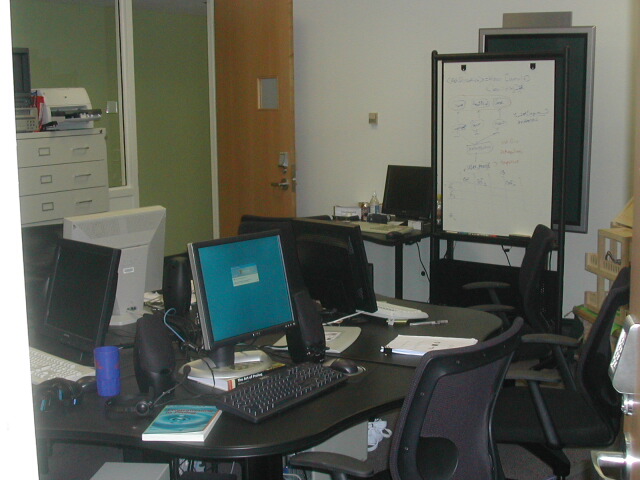
 |
My first week at Northwestern began by meeting everyone
in the lab. Marc Flury is the main IT person in the lab and writes most of
the code for both projects. Yolanda Rankin is a Ph.D. student who is
working on the Sam research project. Paul Tepper is also a Ph.D. student,
but he is working on the NUMACK project. Stefan Kopp is a post-doc working
on NUMACK with Paul. I met with Professor Justine Cassell, and she
introduced me to some people in the Department of Communication Studies.
There are two main projects being developed in the lab,
Sam and NUMACK. Sam is an interactive storytelling peer that can share
toys across the real and virtual worlds through the attic of his playhouse.
Sam is designed to help children learn language and develop their literacy
skills through storytelling. NUMACK is also an embodied conversation agent.
He is a robot that can answer questions and give directions about the
Northwestern campus. NUMACK communicates through speech, gestures, and a
map of the campus.
Both projects were explained to me and some of my project
options were discussed. I spent some time learning how to use CVS, a
version control system, and familiarizing myself with C# and Visual Studio.
I also attended a coding workshop by Paul and Stefan to learn how to code
the words and gestures on videotapes of people giving directions. |
| |
I started to get sick over the weekend and I am only
feeling worse. As a result, I spent most of the week sick in bed.
For some reason, I went in to the lab on Tuesday. I
began working on the eyebrow synchronization of Sam. I looked at the code
Marc had written for Sam's lips, to prevent them from flapping when he
isn't talking. This is similar to that, in determining when Sam should
raise his eyebrows. I started just based on the volume of his voice, but
in order to make it more life-like the pitch of his voice will probably be
used.
I also did some work on the NUMACK project. I took
apart his body, in order to map it onto a skeleton that Stefan made. This
will allow NUMACK's movements to appear more natural and human-like.
|
| |
I am still very sick with pneumonia, so I haven't
been into the lab. See Life in Evanston to
find out more. |
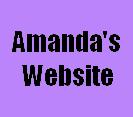 |
Amanda arrived this week. She is also working with
Justine this summer through the DMP program. You can check out her website
from the link to the left.
This week I started out doing some more work on the
eyebrow sychronization for Sam. I combined the code for the lip
synchronization and the eyebrow synchronization, so that it generates one
script.
More importantly, Stefan, Marc, Amanda, and I talked
about some of the possible projects that each of us could work on, and then
decided what we wanted to do. I wrote up a project proposal for Justine
and met with her to discuss my remaining time here at Northwestern. There
are a few things she wants me to expand on, so I will be rewriting the
proposal this weekend. I will continue to rewrite and update the proposal
so that it develops into my final paper.
I am going to be working on the map for the NUMACK
project. It will be a 2D map of the Evanston campus, that will draw a
route given as input. To read more about my project, see my
Project Description page. Amanda is working on
a similar project. She is designing the route planner for NUMACK, so when
asked how to get from A to B, he responds with an appropriate route from A
to B. Since our projects are somewhat related, we will be doing some of
the prelimiary research together.
On Friday, we went to a Women in Computer Science lunch
with Justine. It was really interesting, and Amanda and I both learned a
lot about graduate school. |
| |
I worked on editing my project proposal and doing a lot
of research for the paper. I also installed Open Inventor onto the
computer I use in the lab. Open Inventor is an object oriented 3D toolkit
for graphics programming. I will be using this software to draw and animate
the map. I also looked through The Inventor Mentor and at the
example programs.
Paul and Stefan ran an experiment to help gather
information for NUMACK, such as speech, gestures, routes, etc. There were
28 sets of people, one familiar with campus and one unfamiliar with campus.
The person familiar with Northwestern was asked to give directions to three
different locations on campus, with the intention of the unfamiliar person
to then follow these directions to see if they could get to the locations.
This was all recorded by four videocameras so the data could later be
analyzed. Amanda and I decided that the best way for us to determine routes
and landmarks would be to watch these tapes. We watched these tapes for
about two and a half days this week and managed to get through about half
of them. We started out writing all the directions and landmarks, but
quickly decided this was too difficult and time consuming. So instead we
decided to have a campus map for each person, and hightlight the route and
take notes about all of the landmarks. This seems to be much easier to do
and follow. We hope that from this data we will be able to not only decide
what landmarks to use for our projects, but also that we will be able to
predict landmarks for any route.
We both met with Justine to talk about our proposals and get feedback
about what to add and change. Then the three of us met to discuss an
article she wanted us to read called,"Do Women Lack Ambition?".
Wednesday afternoon we had our first official ArticuLab meeting. At
these meetings, everyone gives an update about what they are doing. We also
decided that each week someone will give a 10 minute talk about their
work. |
|
On Tuesday I had to turn in an updated project proposal,
so I spent Monday working on that. For Thursday I had to give Justine a
"progress so far" paper detailing what I have accomplished thus far. So
Tuesday and Wednesday were very busy. I started to write some code; I
played around with different shapes and curves. I also watched most of the
remaining videotapes. After I wrote my progress paper, I finished watching
the rest of the videos. I also began working on the first version of the
map. |
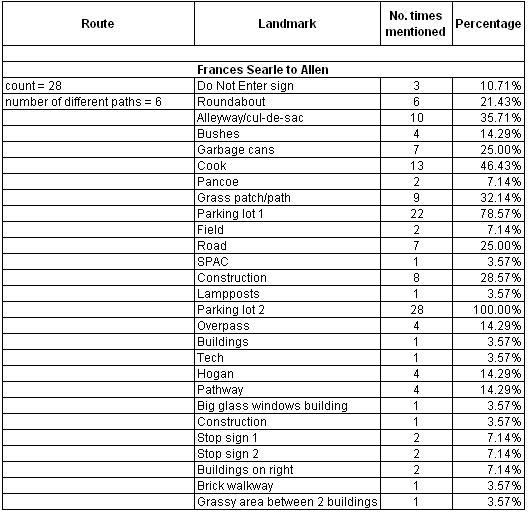 |
This week I spent most of my time working on developing
the first version of the map. This will include only a small part of campus,
based on the routes given for Frances Searle to the Allen Center. I
developed a toolkit of shapes that I will use on the map. Then I began
arranging the shapes to represent this part of campus. I had some problems
along the way, but it's going well for the most part.
On Wednesday, we went to the Realism Lab to see the
graphics demos. There were four different projects presented. The first
was a temporally adaptive display that improves realism by adjusting the
frame rate. The second project automatically generated a realistic city
primarily to be used in games. The third project was an interactive
visualization for monitoring high-volume text, from sources such as the
newspaper or email. The last project was a visualization for summarizing
complex data by viewing many graphs simultaneously. I didn't get a
chance to see the last project, but I really liked the other three.
Amanda and I were asked to create a spreadsheet with the
landmarks included on the path from Frances Searle to Allen Center. This
data will be very useful in determining what to include on the map because
I will have some actual numbers for how often specific landmarks are used.
We decided to rewatch the videos to make sure we had written down everything
that was mentioned in the videos. Then we typed up a spreadsheet including
the different routes, how often they were used, the landmarks mentioned for
each route, and how many times they were mentioned. You can check out the
spreadsheet to the left.
Also, another Ph.D. student, Andrea Tartaro, has joined
Justine's lab for the summer. She is working on creating new flash
animations for Sam. |
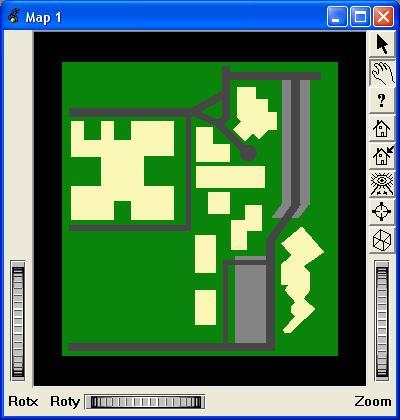
|
In the beginning of the week, I finished the first
version of the map. Then towards the end, I started to work on the
animation of the map. I read a couple more chapters in The Inventor
Mentor about animation, and I made a little bit of progress. :)
On Thursday, Amanda and I attended a talk by Dave Luebke
from the department of Computer Science at the University of Virginia. His
research is focusing on achieving more realistic lighting and surface
reflection in interactive graphics. The technique he talked about was based
on pre-computed light transport and separable bidirectional reflectance
distribution function (BRDF) approximations for interactive rendering of
non-diffuse objects under all-frequency environment illumination. At
run-time, a sparse light vector is multiplied by the sparse transport
matrix at each vertex, and the results are further combined with texture
lookups of the view direction into the BRDF view maps to produce
view-dependent color (taken from the abstract). It sounds really confusing,
but it made sense when he was explaining it.
By attending the talk, we were also able to talk to some
of the professors and grad students studying graphics. They were very
helpful with what grad schools have a strong graphics program. I also
talked to another professor about different schools and what to do and
think about when applying for grad school. It was very informative, and I
feel a little better about the whole application process since it is
approaching quickly. |
 |
Tuesday morning I went with Yolanda to the REBA Early
Learning Center. She is trying to study the effects of a multicultural
Sam, so we went there to collect African American stories from the kids.
We had two kids play in a room with the wooden castle that is used with Sam.
They took turns telling stories while they played with the castle and
people. The stories will eventually be coded into Sam so that he tells
similar stories. It was very fun and interesting. I realized how hard it
is to work with kids and try to get them to cooperate with your research.
A lot of them just did pretend play instead of telling stories.
I also met with Marc to discuss my project and the rest
of my time here. I was unsure of how to do the animation part, and he was
very helpful. So I spent some time this week working on that.
Amanda and I also created a spreadsheet for the rest of
routes and landmarks from the video data. After looking at it, we came to
some conclusions about how people chose landmarks and routes.
Justine asked me to give her another updated draft of my
paper. So I spent a lot of time this weekend working on it. This will be the
last version I write, except for the feedback I get. Even though I am adding
to my original paper, there is still a lot to write about what I actually did.
|
| Week 10 |
July 25 - July 30 |
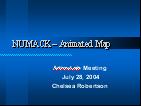 |
Last week was my turn to give a presentation at the lab
meeting, but almost everyone was gone on vacation or at a conference. Paul and
Stefan went to the AAMAS conference to present a paper, and Amanda also went to
attend the conference. Justine was also gone, and she won't be back until
after I leave. :( We decided to hold off on the meeting, so I gave my
presentation this week. I spent some time Monday and Tuesday working on my
power point slides and talk. They had cake and ice cream during the meeting
because I am leaving on Friday, and also gave me, Amanda and Stefan coffee mugs with
a picture of NUMACK on one side and "Go to the arch" and ArticuLab Summer '04 on the
other side. It was so nice of Justine! I wish she was coming back before I leave.
This week Marc and Yolanda are both on vacation. So the lab is
still pretty quiet. I've been working on my final paper some more and on the animation.
Although, I haven't made any new progress on the animation. :(
|
|